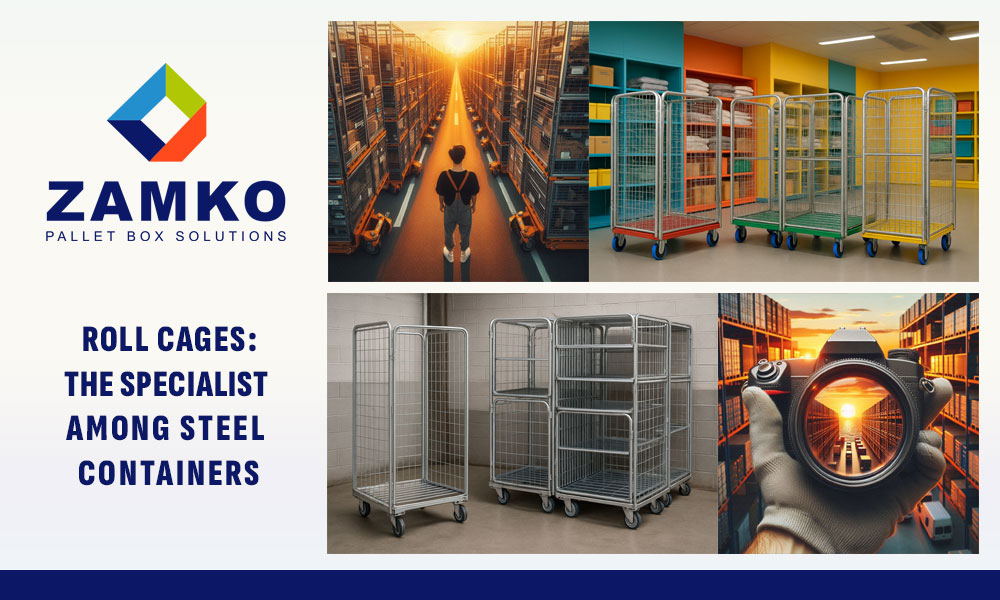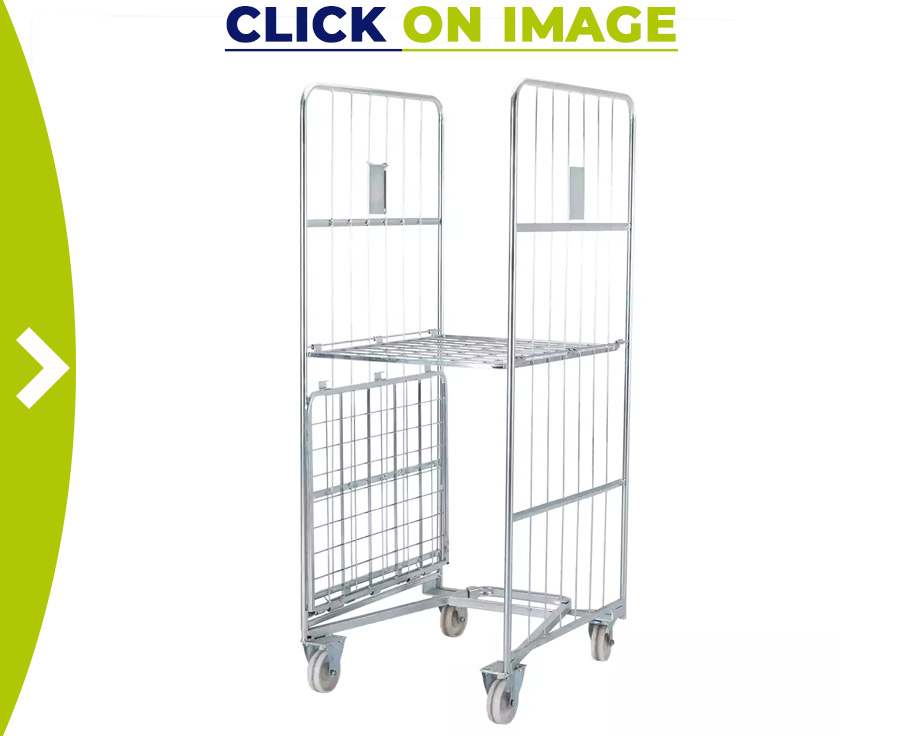Are Roll-Cages Better Than Traditional Steel Containers?

Roll-Cages – The Specialist Among Metal Containers
We use roll-cages — also called roll containers or roll pallets — for specific tasks that demand mobility, durability, and security. These aren’t your average metal containers. They’re engineered to move goods safely and efficiently across sectors where speed and organization matter.
Roll-cages are built with steel frames, mesh panels, and castor wheels. Their open design allows visibility and airflow, while their structure supports stacking, nesting, and secure transport. We rely on them in:
- 🏬 Retail stores for shelf replenishment
- 🏭 Warehouses for order picking
- ✉️ Postal services for parcel sorting
- 🏥 Hospitals for linen and supply movement
- 🧼 Laundries for clean/dirty separation
According to Eurostat, over 70% of European logistics hubs use roll cages daily. Their ergonomic design reduces manual handling injuries and boosts operational speed.
Roll-cages come in several configurations. Each serves a unique purpose. Let’s break them down:
🔹 2-Sided Roll Cages
- Open access from both sides
- Ideal for large, stable items
- Common in bulk transport and automotive
🔹 3-Sided Roll Cages
- Adds rear support
- Suitable for retail and hospitality
- Balances access and containment
🔹 4-Sided Roll Cages
- Fully enclosed with mesh or wire
- Used for small, fragile, or high-value goods
- Often lockable for added security
🔹 Nestable Roll Cages
- Collapse into each other when empty
- Save up to 75% storage space
- Perfect for seasonal or high-turnover operations
🔹 Demountable Roll Cages
- Disassemble when not in use
- Reduce transport volume
- Ideal for multi-location logistics
Each variation is built from mobile steel cages or steel pallet boxes, ensuring strength and longevity. You can explore our product catalog for technical specs and visuals.
Who Uses Roll Cages and How?
Q: Are roll cages only for warehouses?
They are mobile units designed for active environments. Think of them as dynamic, hard-working partners. They move goods efficiently and safely within a facility. Their primary role is not static storage. It is the swift transport of items. This happens in warehouses, retail stores, and distribution hubs. In today’s fast-paced supply chain, efficiency is key..
Here are some examples:
- 🛒 Retail: For moving inventory from stockrooms to shelves
- 🏨 Hospitality: For transporting linens, cleaning supplies, and room service items
- 🏥 Healthcare: For sterile equipment, patient records, and pharmaceuticals
- 🚗 Automotive: For parts staging and assembly line flow
- ✉️ Postal: For sorting and dispatching parcels
- 🧼 Laundry services: For separating clean and dirty loads
In fact, a 2024 report from Logistics Europe found that roll containers reduce handling time by 35% compared to manual carts. Their versatility makes them indispensable.
What Makes Roll-Cages More Efficient Than Other Containers?
We choose roll cages over traditional metal containers for several reasons:
- Mobility: Castor wheels allow smooth movement across floors
- Modularity: Nestable and demountable designs save space
- Security: Lockable doors protect valuable goods
- Visibility: Mesh sides allow quick inventory checks
- Ergonomics: Reduce lifting injuries and fatigue
According to Reco Handling, roll cages improve warehouse efficiency by up to 30% when integrated into picking and packing workflows.
Roll-Cages in Action – Sector-Specific Examples
Retail and Supermarkets: This is a classic environment for roll cages. Staff use them to move products from the stockroom to the shop floor. Imagine restocking a busy beverage aisle. A 3-sided cage can be wheeled directly to the location. This dramatically reduces manual handling. It also speeds up the restocking process. This keeps shelves full and customers happy.
Healthcare and Hospitals: Hygiene and safety are paramount in healthcare. Our zinc-plated mobile steel cages resist corrosion. They are easy to clean and sanitize. Hospitals use them to transport laundry, sterile supplies, and medical waste. A 4-sided, enclosed cage ensures materials are contained safely. This prevents cross-contamination and supports infection control protocols.
Postal and Parcel Delivery: The e-commerce boom changed logistics forever. Sorting centers handle millions of parcels daily. Roll cages are crucial for moving these parcels efficiently. They help sort items for different delivery routes. This system minimizes errors and speeds up the entire process. You can learn more about the complexities of modern logistics on Wikipedia.
Warehousing and Distribution: This is the heartland of steel pallet boxes and roll cages. They are essential for order picking. A worker can move through aisles with a cage. They pick items for multiple orders at once. This method, known as batch picking, improves efficiency. The right cage makes the process ergonomic and fast.
According to Distribution Maintenance, A-frame and Z-frame roll cages are preferred in retail and postal sectors due to their stability and space-saving design.
How Do Roll Cages Support Sustainability?
Roll-cages contribute to greener logistics in several ways:
- Reusable: Unlike cardboard boxes, roll cages are used for years
- Space-saving: Nestable and demountable designs reduce transport volume
- Recyclable: Made from steel, they’re fully recyclable
- Efficient transport: Reduce fuel use by optimizing load capacity
According to the European Logistics Association, switching to reusable containers like roll cages can reduce packaging waste by up to 80%.
Frequently Asked Questions About Roll Pallets
Clients often have questions about our products. Understanding the details helps you make a better choice. Here are some common questions we receive about our metal containers.
Q: What materials are your roll cages made from?
A: Roll cages are build from high-quality, durable steel. This ensures they can withstand tough industrial environments. Most are finished with a bright zinc plating. This finish protects against rust and corrosion. It also makes them easy to clean. This durability means a longer service life for the container. It provides a better return on your investment.
Q: How much weight can a standard roll cage hold?
A: The load capacity can vary by model. However, most of our standard roll containers are rated to carry between 300 and 500 kilograms. This is known as the Safe Working Load. It is important to respect this limit. Overloading can damage the cage and pose a safety risk. We always list the specific capacity for each product. But higher load capacities are always possible on request.
Q: How do roll cages improve worker safety?
A: They significantly reduce the need for manual lifting. This is a leading cause of workplace injuries. A single person can safely move hundreds of kilograms of goods. This lowers the risk of sprains and back injuries. Enclosed cages also prevent items from falling. This protects workers from falling objects. Proper use of roll cages is a key part of a safe workplace.
Q: Are they difficult to move and steer?
A: Not at all. They are equiped with high-quality castors (wheels). They are typically made of nylon or rubber. The design usually includes two fixed and two swivel castors. This combination offers excellent maneuverability. It allows for easy steering, even in tight spaces.
We know roll cages aren’t just metal containers. They’re purpose-built tools that improve safety, speed, and sustainability across industries. Whether you need roll pallets, mobile steel cages, or steel pallet boxes, we help you choose wisely.
Visit our contact page or connect with us on Facebook and LinkedIn. Let’s roll smarter, together.

